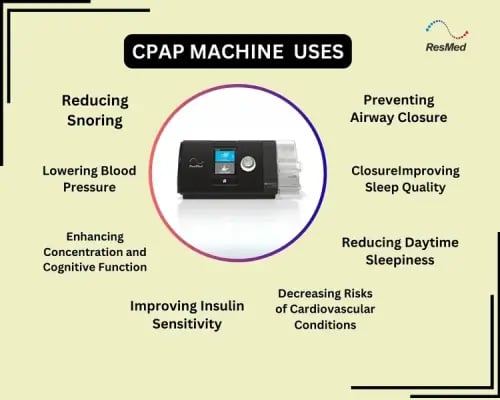Topics: Sleep Apnea, cpap
If you're suffering from sleep apnea, you've likely heard about CPAP machine as a recommended treatment. Sleep apnea, a common disorder where breathing repeatedly stops and starts during sleep, can significantly impact your health and daily energy levels. CPAP, or Continuous Positive Airway Pressure, offers a viable solution to keep your airway open throughout the night enhancing your sleep quality and overall health. In this articles we will discuss about What is CPAP machine, How does it work, It's types, uses, and benefits.
What is CPAP Machine?
CPAP Machine stands for Continuous positive airway pressure machine. It is a medical device designed to treat obstructive sleep apnea by providing a steady flow of pressurized air through a mask. It keeps the airways open during sleep. Developed in the early 1980's, CPAP technology has become the Gold standard in the treatment of sleep apnea. It is basically a small box with a motorized turbine inside. It also has a filter on it to eliminate the intake of dust , smoke, or other impurities in the air. Apart from all these it also has humidification chamber that warms the water in order to humidify the pressurized air before it is delivered.
How does a CPAP Machine Works?
The CPAP machine consists majorly into three parts:
- CPAP Motor: The CPAP motor fan draws in the room temperature air, which passes through the filter, and pressurizes it to gently deliver the right amount of air. The humidification chamber warms this pressurized air before it is delivered. And though it is optional, it brings relief for the majority of patients who wake up with a dry mouth, nasal passages, or throat.
- CPAP Hose: CPAP hose ensures that the air is delivered by transferring it from the motor, to the mask.
- CPAP Mask: The CPAP masks deliver clean, purified and humidified air that clears the obstruction in the airway of the patient. Thus the CPAP device allows the patient to breathe freely in his sleep.
The machine's motor generates a continuous stream of air that travels through a hose to a mask covering the nose, mouth, or both. This pressurized air prevents the airway from collapsing during sleep, thus eliminates interruptions in breathing.
Types of CPAP Machine
There are several types of CPAP machines available:
- Standard CPAP: Delivers a fixed air pressure throughout the night.
- Auto-adjusting CPAP (APAP): Automatically adjusts the pressure in response to breathing patterns.
- Bi-level CPAP (BiPAP): Provides different pressures for inhalation and exhalation.
Each type of CPAP Machine are designed for different patient needs, depending on their specific sleep apnea characteristics and personal comfort preferences.
CPAP Machine Uses
Continuous Positive Airway Pressure (CPAP) machine is used in the treatment of sleep apnea, a condition characterized by frequent pauses in breathing during sleep. CPAP Machine helps people with Obstructive Sleep Apnea (OSA) breathe easily in their sleep. It uses a hose and mask to deliver constant and steady air pressure and prevents your airway from collapsing when you inhale. Here are the primary uses and benefits of CPAP machines:

- Preventing Airway Closure: By delivering a constant airflow, CPAP machines keep the throat muscles and airway open, preventing the collapses that lead to apneas or hypopneas (shallow breathing) during sleep.
- Improving Sleep Quality: CPAP therapy significantly reduces sleep disturbances caused by sleep apnea, leading to more restorative sleep and better overall health outcomes.
- Reducing Daytime Sleepiness: Individuals with untreated sleep apnea often experience excessive daytime sleepiness due to disrupted sleep. CPAP use can alleviate this symptom, improving alertness and performance during the day.
- Lowering Blood Pressure: Sleep apnea is linked to increased blood pressure and cardiovascular problems. Regular use of a CPAP machine can help lower blood pressure levels, contributing to heart health.
- Decreasing Risks of Cardiovascular Conditions: CPAP therapy is associated with a reduced risk of heart-related conditions, including heart attacks, strokes, and arrhythmias, by improving breathing patterns during sleep.
- Improving Insulin Sensitivity: Regular CPAP use has been shown to improve insulin sensitivity in individuals with sleep apnea, reducing the risk of type 2 diabetes.
- Enhancing Concentration and Cognitive Function: By improving the quality of sleep, CPAP machines can help enhance cognitive function, including memory, attention, and decision-making abilities.
- Reducing Snoring: A significant benefit for both the individual using the CPAP machine and their partner is the reduction or elimination of snoring, leading to a quieter sleep environment.
CPAP machines are a key treatment option for obstructive sleep apnea, offering a non-invasive solution to a common and potentially serious condition. By maintaining open airways, they enable individuals to achieve better quality sleep and reduce the risk of associated health problems.
How to Use CPAP Machine

To follow your diagnosis, you will need to get the CPAP kit: the machine, hose and the mask. You will need to assemble the equipment, and follow the instructions for the same. It's very simple.
The main goal is to use the CPAP machine every night for as long as possible in order to enjoy the benefits of a quality sleep and good oxygen levels in the blood. But there are few other points worth noting before you start using it:
- Determine the air pressure setting that best benefits your condition.
- Find a good-fitting comfortable mask. Masks come in several variations, like nasal or full face, and in different shapes and sizes. It is best to try a few and see which style fits your face comfortably.
- While using the device, ensure that the seal over your airways is tight enough. This is important as it allows for continuous air pressure from your CPAP.
- You may find it difficult to get used to the forced air from a CPAP device. Consider switching to the ‘ramp’ feature, as this setting has low pressure air to make you tolerant to the technique.
- A stuffy nose as a result of using the machine may be because of a leaking or broken mask. Test your device before using it.
- Some may need to use a chin strap to keep your mouth closed at night. This will avoid breathing through your mouth, and reduce leakage of air while you use a nasal mask.
- If your CPAP machine is making a lot of noise, it may be due to the jammed filter. Check that the filter is clean, and nothing is blocking the path of air in it.
Recent Advances and Technological Innovations
Technological advancements in CPAP machine have focused on enhancing user comfort and connectivity. These include quieter motors, improved mask designs, and wireless data transmission to healthcare providers for better monitoring and compliance.
Conclusion
CPAP machine play a crucial role in managing Obstructive sleep apnea, improving sleep quality and reducing associated health risks. Work with your doctor to troubleshoot any problems you face initially, and adjust settings if needed. Some machines also have data which you can share online with your doctor, and they can determine if your device requires a change in settings. It might take a little while to find the correct settings and get used to the mask.
For your own healthy sleep regime, it is advised to use CPAP machines regularly. Do not stop using it without consulting your doctor, even after decreased severity in symptoms. Sometimes it can get frustrating trying to get used to the CPAP machine, but it is important that you stick with it. You will get used to it in some time. What is more important is that it will give you the best sleep you have had in a long time. The treatment helps you avoid complications of obstructive sleep apnea, and can positively affect your quality of life and health.
With ResMed, you can take a CPAP Trial for 2-weeks before starting the CPAP therapy, and see for yourself how effective it is.
FAQ’s Related to CPAP Machine
Now you have read all about CPAP Machine. You may want to read how to Use CPAP Machine for better sleep, Portable CPAP Machine for Travel, Its Use During Nasal Congestion, and How to clean CPAP Machine.




